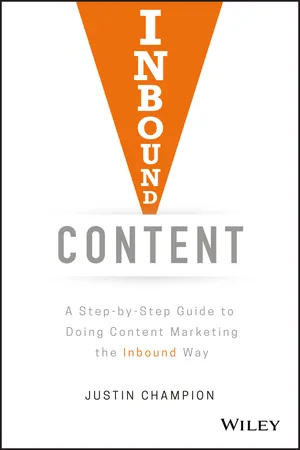
Inbound Content
A Step-by-Step Guide To Doing Content Marketing the Inbound Way
- English
- ePUB (mobile friendly)
- Available on iOS & Android
About this book
Develop and implement an effective content strategy tailored to your business ' s needs
Inbound Content is a step-by-step manual for attracting the right people, turning them into leads, and closing them into customers. Today, everyone knows that content is king. It's how we engage, how we inform, and how we pass the time; content is everywhere, and if you're not leveraging its power to promote your business, you've already been left behind. Having a website and social media is not enough; if you truly want to take advantage of unprecedented levels of connectedness, you have to create content that draws customers in. It's not about blindly expanding reach, it's about reaching out to the right audience. Today's marketplace is no longer about chasing the sale—with the right approach to content, your customers will come to you.
Your content must be valuable, relevant, and consistent—but how should it be implemented at the actual content-creation level? This book shows you how to develop a unified strategy, create compelling content tailored to your needs, and utilize that content to its greatest advantage in order to build your brand.
- Discover the power of storytelling and generate effective content ideas
- Plan a long-term content strategy and a content creation framework
- Create great content, promote it, measure it, and analyze its performance
- Extend your content's value, become a more effective writer, and develop a growth mentality
Effective content is worth its weight in marketing gold. It stands out from the noise, and to the customer, looks like an oasis in a desert of clickbait and paid reviews. Inbound Content shows you how to plan, build, and implement your content strategy for unprecedented engagement and sales.
Frequently asked questions
- Essential is ideal for learners and professionals who enjoy exploring a wide range of subjects. Access the Essential Library with 800,000+ trusted titles and best-sellers across business, personal growth, and the humanities. Includes unlimited reading time and Standard Read Aloud voice.
- Complete: Perfect for advanced learners and researchers needing full, unrestricted access. Unlock 1.4M+ books across hundreds of subjects, including academic and specialized titles. The Complete Plan also includes advanced features like Premium Read Aloud and Research Assistant.
Please note we cannot support devices running on iOS 13 and Android 7 or earlier. Learn more about using the app.
Information
Chapter 1
Building a Content Creation Framework
Why Does Your Business Need a Framework for Creating Content?
How Do You Build a Framework for Creating Content?
- Conceptualize your content.
- Plan and set timelines.
- Create a content workflow.
- Review and edit your content.
- Publish and promote.
- Organize your content internally.
- Analyze the results.
- Evolve your process.
Start by Conceptualizing Your Content
- Your buyer personas

- The buyer's journey

- Awareness stage: The buyer identifies there's a problem that's happening. This person is performing research to learn more and find a possible solution.
- Consideration stage: This person has found one or more solutions to their problem. Now they're looking for the solution that best meets their needs.
- Decision stage: This person is ready to make a well-informed decision, which is usually purchasing a specific product or service.
- Awareness stage: I have a lot of unstructured text data and need to make sense of it. What should I do?
- Consideration stage: Aha! There's an automated solution to categorize comments and detect emotions in real time in multiple languages.
- Decision stage: I can receive a free consultation of my business's customer feedback data.
Next, Plan and Set Timelines for Content Creation
Table of contents
- Cover
- Title Page
- Copyright
- Dedication
- Foreword
- Preface
- Acknowledgments
- About the Author
- Introduction: Your Content Marketing Transformation
- Chapter 1: Building a Content Creation Framework
- Chapter 2: The Power of Storytelling
- Chapter 3: Generating Content Ideas
- Chapter 4: Planning a Long-Term Content Strategy
- Chapter 5: Becoming an Effective Writer
- Chapter 6: Creating a Blog Post
- Chapter 7: Extending the Value of Your Content through Repurposing
- Chapter 8: How to Effectively Promote Content
- Chapter 9: Measuring and Analyzing Content
- Chapter 10: Developing a Growth Marketing Mentality
- Chapter 11: Creating Topic Clusters and Pillar Pages
- Chapter 12: The Results
- Glossary
- Index
- End User License Agreement